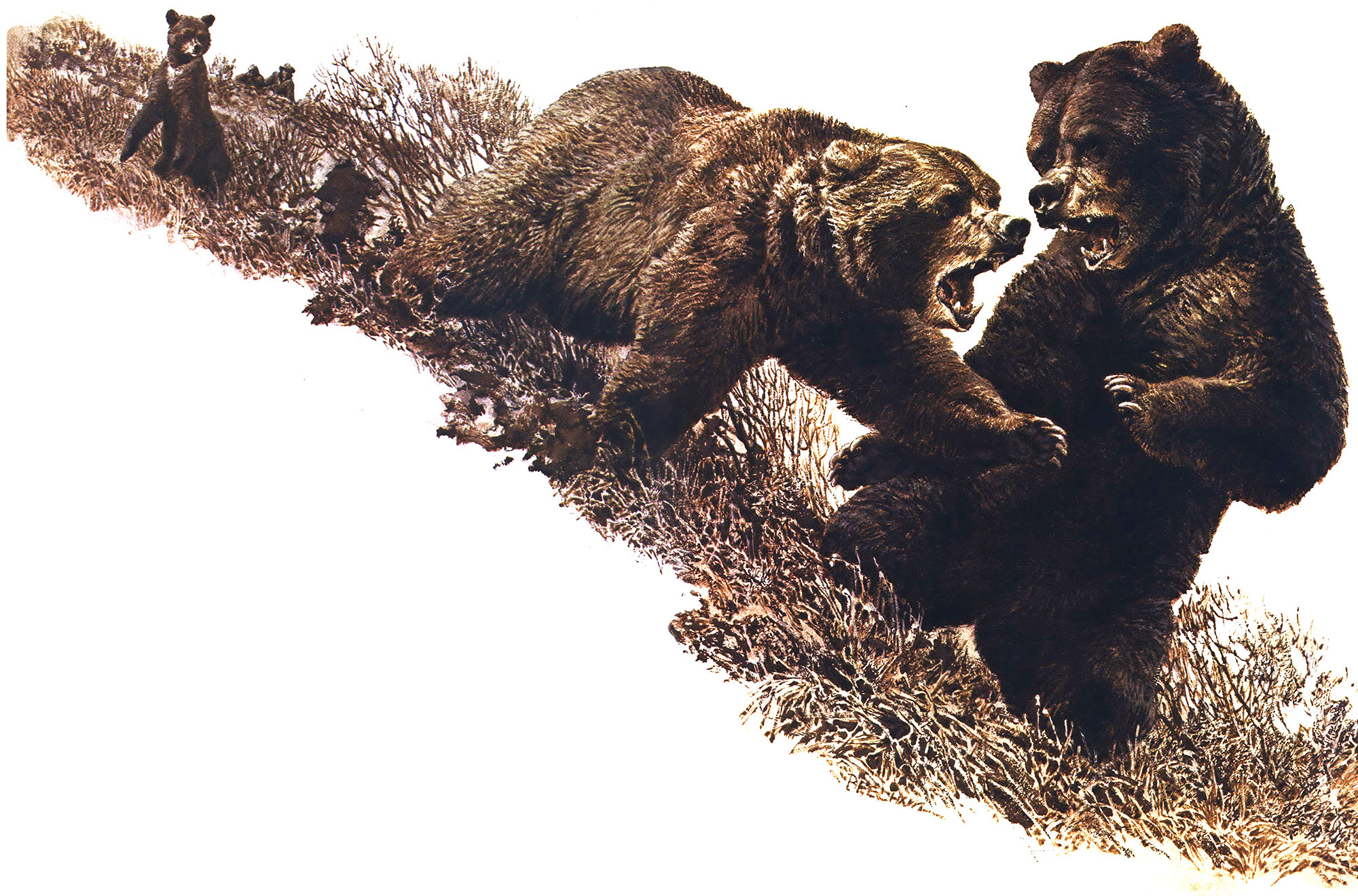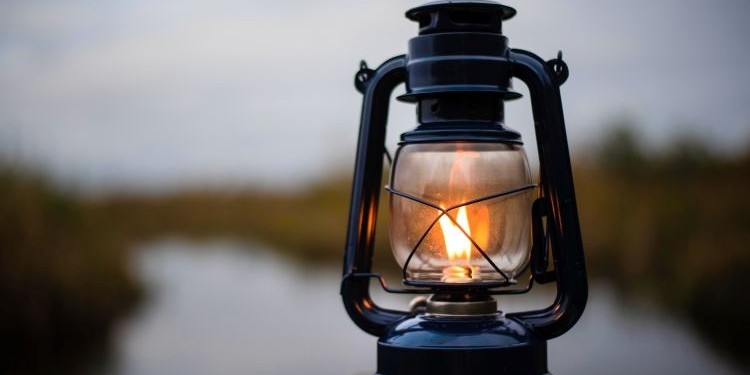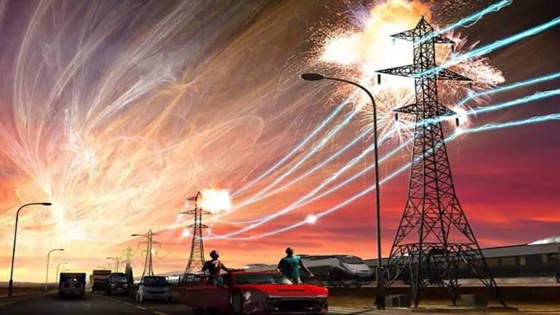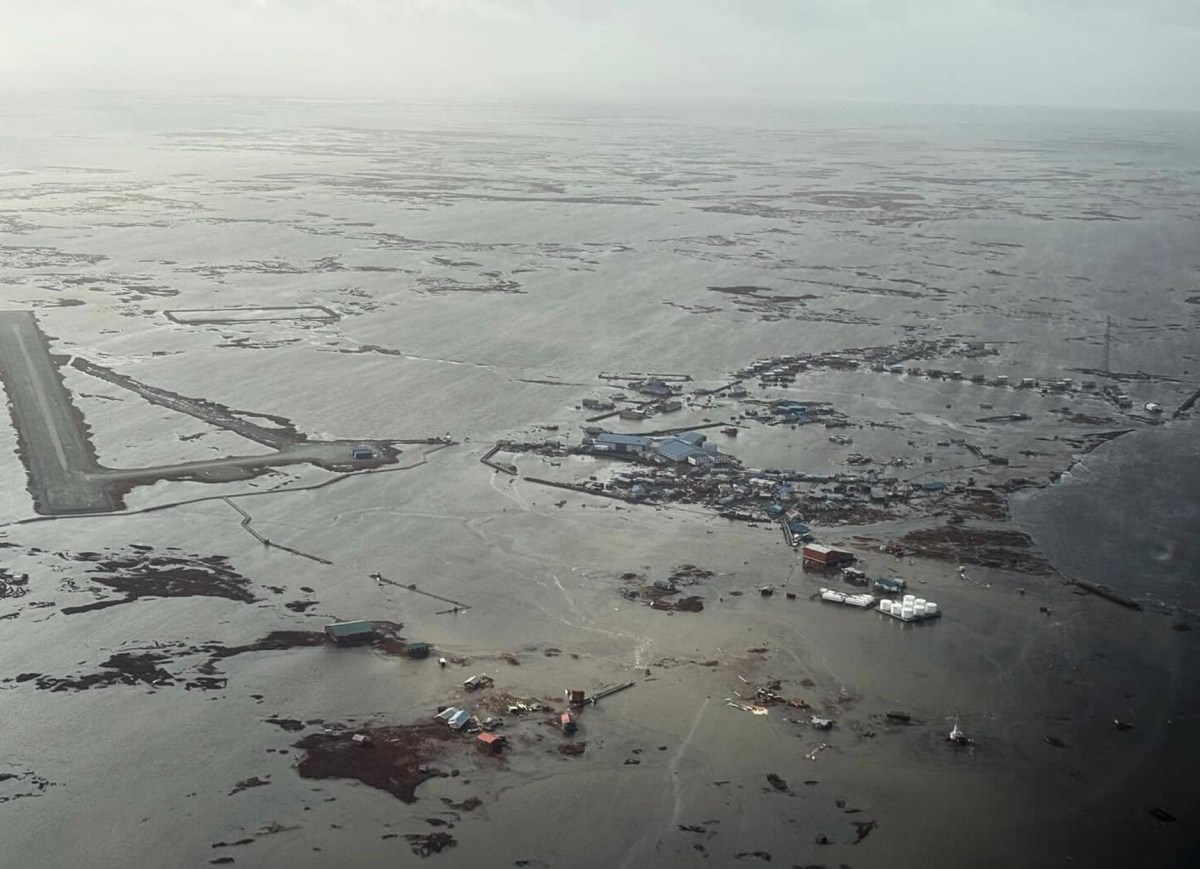We Stalked a Cannibal Brown Bear That Was Trying to Kill a Cub

This story, “Stalk for a Cannibal Brown,” appeared in the July 1977 issue of Outdoor Life. Infanticide among brown and grizzly bears is not unusual, as we’ve previously written.
I swept the big 8 x 56 Zeiss binoculars slowly over the hills, along the snow-covered mountaintops, and down the veining ridges on Alaska’s Kodiak Island. Then I lowered the glasses and squinted into the glaring rays of the May sun hoping to see some sign of life in the same vast area. I was looking for a bear. My client, Siegfried Kube (cou-ba), and his wife Brigette from Heidelberg, West Germany, sat in the alpine meadow nearby scanning the country as intently as I.
For two days we had tramped the hills and boated the shoreline of Uyak Bay on the western side of Kodiak, glassing one likely area after another. We had seen only one small sow and her two cubs. Both youngsters had light cream-colored collars, characteristic of many new brown bear cubs. The scenic beauty of the hills, however, did much to pacify us during the long days. A 15-hour day in the field during a spring hunt is not uncommon at this time of year because of the rapidly increasing daylight as summer draws near.
The third day found us on a high mossy knob that overlooked our main camp to the nor th. South of us a spread of mountains and draws fingered their way toward the twisting Karluk River, one of the finest sportfishing rivers in the state.
Siegfried is the 36-year-old owner and manager of several photographic plants in West Germany, and his wife is a partner in the business. Both experienced hunters, they had booked with our camp early in 1973 for a hunt in May, 1974, on what should have been one of two bear hunts for them on the North American continent. However, their polar bear hunt in the Northwest Territories, which was to precede the brown-bear hunt with me, was cancelled when a French hunter, all guides, and a dog team were lost on the ice pack. The bodies were never found. Polar bear season was officially closed for the year. The Kubes wound up in my camp early, unhappy but understanding, and with some misgivings about bear hunting in general.
I’m a full-time hunting guide on Kodiak, and I guide and outfit exclusively for brown-bear hunters from three camps on the island during the spring and fall seasons. My camp lies within the boundaries of an ancient salmon cannery site called Old Uyak. It’s at the confluence of Uyak Bay and the storm ridden waters of Shelikof Straits. My wife Judy and I and our four children spend a little more than seven months of the year here, hunting during the bear seasons, commercial salmon fishing during the summer months, and trapping at the close of the fall brown bear season. Judy is the camp cook, our children the camp help, and I hire one or two licensed guides for the hunting seasons. The Christmas holidays find us back at our home in the town of Kodiak for the winter. I always find myself anxious to return to camp for the spring hunts, and I was happy to be with the Kubes.
Around one o’clock I dipped into my pack and hauled out sandwiches, dried fruit, and homemade sweet rolls, and poured steaming cups of tea. We relaxed under the warm sun enjoying lunch and talking in low tones. Leaning forward, I focused dimly on an object some three miles away on the open skyline. Snapping up the glasses, I swung on the dark spot and pulled it in closer. It moved! Brigette said, “A bear, a bear!” We both saw it.
Siegfried moved in at full alert. I watched the bear through the glasses and marveled at its size. Even with out the binoculars, he was enormous on the skyline. We zeroed Siegfried in on the bear. The three of us then watched as he padded slowly along the mountain. We watched for 10 minutes until the bear turned and disappeared from view.
“What do you think, Leon?” Sieg fried asked excitedly.
Even with long hours of daylight ahead, the bear was far off for the time we had. He was high in the snow, he was traveling, and he’d disappeared. There was only a slim chance that we’d ever see him again. I briefed Siegfried on the situation, but added that even at this distance, the bear looked awfully big and I thought we had better have a closer look. He jumped at the chance.
To go after the bear meant dropping some 800 feet from our lookout and crossing a three-quarter mile val ley below. Then, climbing a 500-foot slope upward through a mile of heavy brush, we’d beeline for one end of a small lake, cut across a quarter mile of muskeg behind it, then onward and up the 1,800-foot mountain where we had last seen the bear. It would be a hurried stalk. Because of the time and distance involved, Brigette decided to return to camp. We loaded Siegfried’s knapsack with extra clothing and cameras, and Brigette buckled it on. We pointed her for camp only a short distance away.
The wind had decreased to nothing, and a fine misty rain fell steadily. Without warning the full-throated roar of a bear echoed up to us.
Stuffing the bare essentials into my pack, I jabbed Siegfried with, “Think you can make it?” He nodded excitedly. We looked for a few moments at our intended route. Then, dropping from our lookout at a fast pace, we were on our way.
An hour and 45 minutes of hard going put us in the muskeg near the small lake. Almost thankfully a few clouds began to block the heat of the sun. There was no wind. Then we rounded the lake and hurried across the swamp.
Progress on the steep mountain side was at a snail’s pace. Climbing, slipping, and falling on the slope, the pace began to take its toll of us. We would climb, rest a moment, then stagger on. We hit snowlike at 1,500 feet. Here a firm base beneath an inch of slushy snow gave us better footing. The now-gradual rise to the crest made the going easier. We took a 10-minute break near the top. A cool wind rose from the east. We zipped on down jackets, checked our rifles, and headed for the top.
Video: Large Male Grizzly Kills Another Bear in Yellowstone National Park
Siegfried’s rifle was an F.N. semi automatic in .300 Winchester Magnum, an exact twin of the current Browning semi-auto that is sold in the U.S. The rifle was equipped with an 8X Zeiss scope, set on the Euro pean style claw-type mounts, and loaded with 220-grain soft-nose bullets. My constant companion when hunting brown bear is an old-model, seven-pound Sako rifle. It is a .375 Magnum and is outfitted with a Sako peep sight with the aperture bored out to 3/16 inch. The barrel is chopped to 19 inches for brush use, and I handload 300-grain Silvertip bullets in front of 71½ grains of fast burning 4064 powder for maximum velocity in the short barrel.
The long, straight valley below ended two miles to our left at the ocean’s edge. Within a mile and a half to our right it faded into the western end of the expansive Kaduk Flats. For a full 15 minutes we glassed the valley until the increasing wind chilled us into movement. We then followed the sharp ridge to its end toward the flats. There we dropped below the snowline, out of the wind, and resumed our vigil.
About 5:30 p.m. Siegfried asked nonchalantly, “Leon, what is this?” I looked over and saw him pointing into the flats. Following his rigid arm, I saw a stationary black blob far out in the open muskeg.
“That’s him,” I said. Again I grabbed the glasses, knowing it was the bear. “That’s him and he’s on the way.” The bear was a mile away on the valley floor and 1,500 feet be low us. But he was headed toward us. He paused here and there and many times faded into the dense alder and elderberry patches. Then he would emerge again, still coming.
By 7 o’clock the bear was directly below us and still moving up the valley. Since the brush was much too thick to cut off or stalk the bear, we began traveling with him straight along the mountainside and hoping for some kind of a break. The bear moved more steadily now, and it took a real effort to stay abreast of him. Halfway across the mountain side we followed until he disappeared, this time into a tall stand of cottonwoods on our side of the valley.
For another 20 minutes we strained to see some movement in or around the cottonwoods. The wind had decreased to nothing, and a fine misty rain fell steadily. Without warning the full-throated roar of a bear echoed up to us.
“What’s this?” Siegfried asked.
“Must be another bear in there.” I shot back, trying to get something in the glasses. Suddenly the alder tops waved frantically 300 yards below and a bit ahead of us. The waving trail of alders continued upward and ahead and disappeared behind a steep knoll in front of us.
We raced ahead 150 yards to the alpine knoll and then paused. I dropped my pack, and we eased over on our bellies through the dwarf willows. There a scant 75 yards away on the barren mountainside, a heavy sow, with ears flattened and fur raised, stood defiantly facing down hill. Her yearling cub raced frantically around her trying to coax her toward the crusted mountaintop. Fifty feet below them lay the huge, dark bear, spread-eagled on his stomach in the grass. His eyes were glued to the cub’s every movement. All the while we watched him, the big bear emitted a constant deep, exhaling huhh-huhh-huhh noise. My first thought was that the boar wanted the sow for a mate, but it soon became apparent that I was wrong. The male was watching the cub’s every move with intent.
The sow, uncertain of the situation, turned and came directly toward us at a fast gait. We jumped from our prone positions and I whistled. Still she came.
The cub was out of his mind with fear. Racing from the sow a few feet, he’d then tear back to duck behind her. At times he slammed into her with a solid whomp. Then off again. Each time the cub reached out a bit too far, the boar came to a full alert and raced toward it.
The sow then bolted toward him with a fierce charge that made our 75-yard distance seem too close. With a healthy respect for the sow’s tenacity, the boar would turn tail, run downhill a few feet, and circle back to lie down and continue his huffing noise. The sow then walked slowly to the cub, every blond hair on her back straight in the air. The sequence repeated itself time and again.
We had decided long ago that the boar would go 10 feet plus. Not taking any chances, I had Siegfried train his rifle on the boar. He watched much of the goings on through his scope.
Suddenly the sow outdid herself in a roaring downhill charge at the boar. Finding his opening, the boar leaped aside. Caught up in her own momentum, she reeled past the boar and tore up bushel-size chunks of moss while trying desperately to wheel and head back toward her cub. The boar bolted headlong for the cub, who panicked for the top. The big bear almost closed the gap in seconds, and the cub reversed direction, hoping for safety from downhill speed and the sow. For a flat second the boar paused and snapped his head around to check the sow’s progress.
“Shoot him, Sig … hit him,” I said. His rifle raked the stillness of the valley. The boar flinched and staggered forward.
“Again,” I yelled, and the .300 roared a second time. The boar broke into a dead downhill run and then pitched forward in a 150-yard tumbling roll down the hill. Brought to a screeching halt by the sound of rifle fire, the sow and cub watched the boar roll. Losing sight of him, they scampered a few feet to a knob and, with necks craned, watched the boar roll to a dead stop in a patch of thick elderberry.
The sow, uncertain of the situation, turned and came directly toward us at a fast gait. We jumped from our prone positions and I whistled. Still she came. I unslung my rifle and yelled sharply. At 40 yards she stopped and stared at us blankly. Finally, she woofed her cub into motion and they stormed over the mountaintop.
We waited a few minutes to study the thicket where the boar had stopped, and then we went down. Siegfried was beside himself with excitement. The bear was more than we expected, and one of the largest I’d seen in some time. A quick taping of the front pads showed the widths to be just under 9½ inches, the length just over 13 inches.
With darkness on the move and two hours to go to hit the beach, we decided to leave the bear and return the next day.
We reached the ocean’s edge at dark and built a roaring fire on the beach. The hard miles and excitement of the day had left Siegfried totally exhausted. I left him by the warmth of the fire and started out on the three-mile walk along the beach to camp.
At 11:30 p.m. I picked him up in one of our small Boston Whalers, and we returned to camp for a midnight dinner and a welcome rest. The next morning broke bright, calm, and clear. We returned by boat to where I had picked Siegfried up the evening before. With Brigette along, we hiked to the bear.
Read Next: These Alaskans Stopped a Charging Grizzly at 5 Yards with Their 10mm Pistols
We took several pictures, and since we were long on time, I did an extra close job of skinning, fleshing the hide white-clean with a curved knife as I skinned. Siegfried carved the skull clean. The skull later missed Boone and Crockett minimum scores by 1/16 inch, but scored enough to go well into the Alaska Record Book. The clean hide and skull weighed a total of 168 pounds back at camp. The green hide stretched loosely on our warehouse floor measured 11 feet 4 inches from the tip of the right front claw across to the tip of the left claw, and nine feet 8½ inches from the tip of the nose to the tip of the tail. Adding these two measurements together and dividing by two is the method used for figuring the squared size of a bear hide. Siegfried’s bear was just over 10 feet 6 inches.
As we rubbed the last bit of salt into the hide, the happy German smiled and said, “You know Leon, I don’t miss so much the polar bear now.”
Read the full article here









